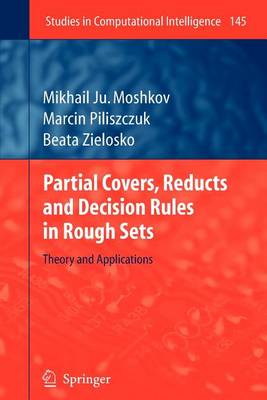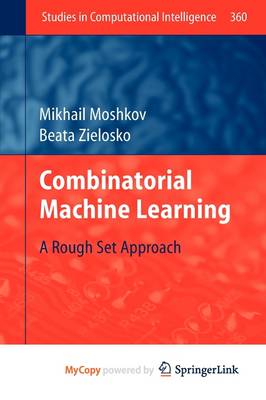Studies in Computational Intelligence
2 primary works
Book 145
Partial Covers, Reducts and Decision Rules in Rough Sets
by Mikhail Ju. Moshkov, Marcin Piliszczuk, and Beata Zielosko
An essential part of software used in experiments will be accessible soon in RSES-RoughSetExplorationSystem(InstituteofMathematics,WarsawU- versity,headofproject-ProfessorAndrzejSkowron). We are greatly indebted to Professor Andrzej Skowron for stimulated d- cussionsand varioussupportof ourwork. We aregratefulto ProfessorJanusz Kacprzykforhelpfulsuggestions. Sosnowiec,Poland MikhailJu. Moshkov April2008 MarcinPiliszczuk BeataZielosko Contents Introduction...1 1 PartialCovers,ReductsandDecisionRules ...7 1. 1 PartialCovers...8 1. 1. 1 MainNotions...8 1. 1. 2 Known Results...9 1. 1. 3 PolynomialApproximateAlgorithms...10 1. 1. 4 Bounds on C (?)Based on Information about min GreedyAlgorithm Work...13 1. 1. 5 UpperBoundon C (?)...17 greedy 1. 1. 6 Covers fortheMostPartofSetCoverProblems...18 1. 2 PartialTests and Reducts...22 1. 2. 1 MainNotions...22 1. 2. 2Relationships betweenPartialCovers and Partial Tests...23 1. 2. 3 PrecisionofGreedyAlgorithm...24 1. 2. 4 PolynomialApproximateAlgorithms...25 1. 2. 5 Bounds on R (?)Based on Information about min GreedyAlgorithm Work...26 1. 2. 6 UpperBoundon R (?)...28 greedy 1. 2. 7 Tests fortheMostPartofBinaryDecisionTables...29 1.
3 PartialDecision Rules...
Book 360
Decision trees and decision rule systems are widely used in different applications
as algorithms for problem solving, as predictors, and as a way for
knowledge representation. Reducts play key role in the problem of attribute
(feature) selection. The aims of this book are (i) the consideration of the sets
of decision trees, rules and reducts; (ii) study of relationships among these
objects; (iii) design of algorithms for construction of trees, rules and reducts;
and (iv) obtaining bounds on their complexity. Applications for supervised
machine learning, discrete optimization, analysis of acyclic programs, fault
diagnosis, and pattern recognition are considered also. This is a mixture of
research monograph and lecture notes. It contains many unpublished results.
However, proofs are carefully selected to be understandable for students.
The results considered in this book can be useful for researchers in machine
learning, data mining and knowledge discovery, especially for those who are
working in rough set theory, test theory and logical analysis of data. The book
can be used in the creation of courses for graduate students.

